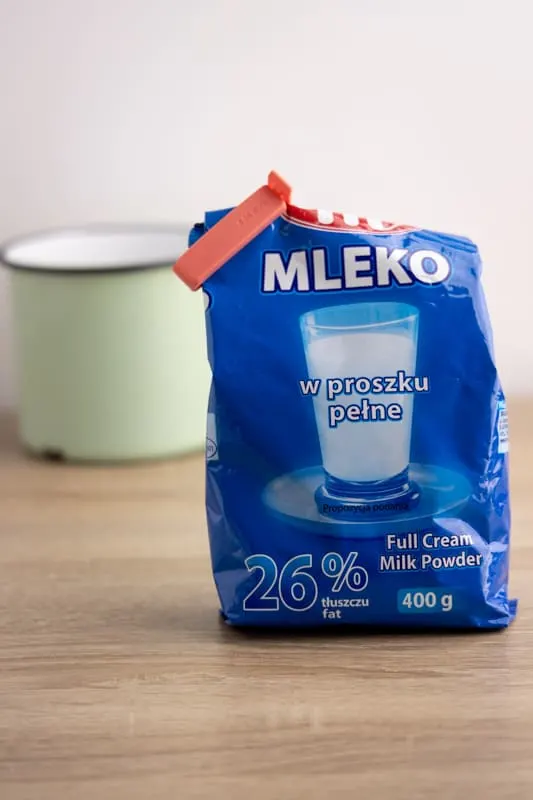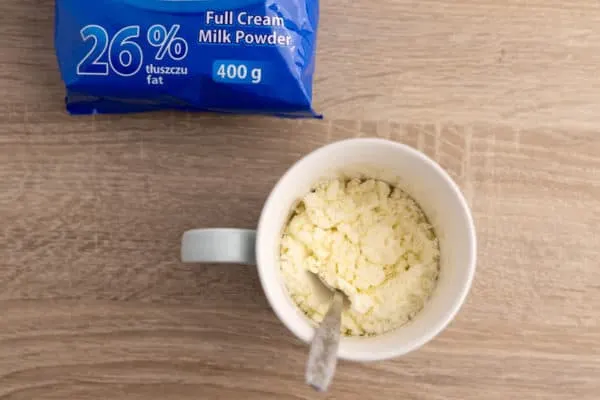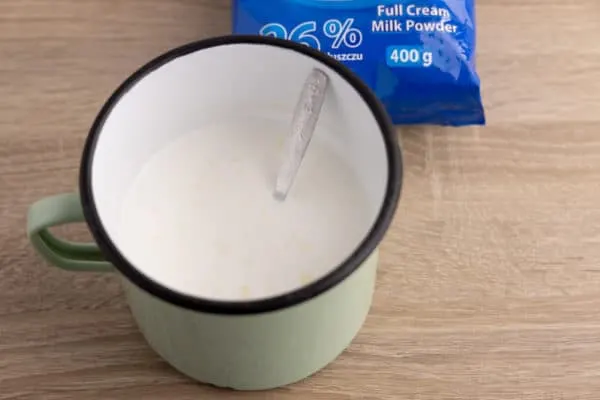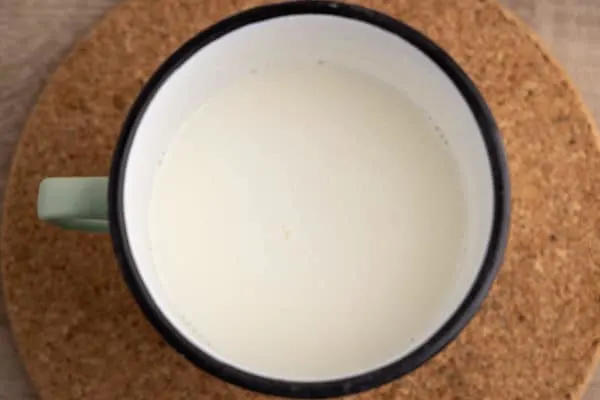Let’s talk about the shelf life and spoilage of powdered milk.
Found an old bag of dry milk that’s a couple of months past its date, and not sure if you can use it? Does powdered milk ever go bad?
Or maybe you’ve just opened a fresh bag, and you’re wondering how long powdered milk lasts.
Sounds like you?
If so, this article is for you. Read on.

Table of Contents
- Does Powdered Milk Go Bad?
- How to Tell if Powdered Milk Is Bad?
- How Long Does Dry Powdered Milk Last?
- How To Store Powdered Milk?
- Powdered Milk Shelf Life and Spoilage Summary
Does Powdered Milk Go Bad?
Powdered milk lasts months, if not years, but it doesn’t retain quality forever. If stored long enough, it will lose most of its vitamin content, and its flavor might alter, but it will stay safe to drink.
That is, of course, assuming that water and pantry pests don’t get access to the powder.
For starters, vitamins don’t last forever, and the amount that’s available in powdered milk lowers over time. So if you drink milk reconstituted from powder to supplement vitamin D, ensure your powder is fresh.
Next, dry powdered milk contains a bit of fat, and as you probably know, fat can go rancid if stored in poor conditions or long enough.
(That same process is responsible for making your oils smelly and sharp-tasting if stored for months on end.)
That rancidity may or may not cause off flavors in the reconstituted milk. And even if it does, it may or may not matter to you.
If you need that glass of milk for a smoothie or to bake something, other ingredients will surely overpower that slight rancid aftertaste. But if that glass of milk is what you add to your cereals, it might be an entirely different story.
That said, the full-fat dry milk variety has the most fat out of all available types, and it’s the one that’s most prone to the taste change caused by rancidification.
With that out of the way, let’s talk about the signs of spoilage of powdered milk.

How to Tell if Powdered Milk Is Bad?
Discard powdered milk if:
- It’s infested. If pantry bugs got into the package, it’s done for. And make sure you check other food products nearby and remove any pests, so they don’t spread all over the place. If left to their own devices, pantry insects spread like wildfire.
- There’s mold inside or any wet clumps. If the package hasn’t been sealed tight and water got inside, there might be mold growing or at least some wet clumps in the bag. If that’s the case, discard the whole thing.
- It smells off. If the powder gives off a weird or unpleasant smell, it’s no good.
- The quality of rehydrated milk is bad. If your powdered milk has been stored for months in poor conditions, the taste might start to reflect that. That’s most common for whole-fat powdered milk, as its relatively high fat content makes it more prone to rancidity.
Those are the typical signs of spoilage for powdered milk.
In general, if the powder seems just fine, reconstituted milk should be okay too.
But before you use that rehydrated dry milk in a recipe, take a tiny sip to assess the quality. And if it’s not good enough to use, toss it and open another bag.

How Long Does Dry Powdered Milk Last?
Dry milk stays good to use for months, if not years, past the printed date if stored properly. It typically comes with a shelf life of 9 to 24 months, and skim milk powder usually has a longer declared storage time than whole milk powder.
That said, the vitamin content degrades over time, and that’s why the date on the label is often only a year or less from the production date. So if you want to take advantage of the added vitamin D, use the powder before its date.
When it comes to how long the powder will retain quality, it’s all about storage temperature and whether it’s fat-free or not.
If stored at a cold temperature (like 50°F (10°C) or less), the powder keeps quality for a couple of years, while if stored at room temperature, it develops off-flavors much sooner. So if you expect it to sit around for a long time, pick a cool place instead of a kitchen cupboard.
Next, whole milk powder loses quality sooner than non-fat milk powder. That’s because of its fat content, which will go rancid and cause off-flavors sooner or later. So if you’re looking for the more stable variety of the two, choose the non-fat one.

After Opening
Once you open a bag of dry milk, the powder should retain quality for up to a few years if it’s sealed tight and in a cold place. If you leave it at room temperature, it’ll probably start to taste off within one to two years.
Of course, that’s just a general estimate, and things will be slightly different in each case.
Furthermore, all of the considerations from the previous section also apply to open dry milk. That means full-fat dry milk doesn’t retain quality nearly as well as non-fat one, and the storage temperature will determine how long yours will keep its flavor.
Now, if you’re lucky, you might stumble upon whole milk powder that you’re supposed to finish within a couple of weeks of opening. What’s the deal with that?
First, it is a very odd recommendation, as people buy dry milk primarily because of its long shelf life. And a few weeks after opening definitely doesn’t fit that criterion. But I get the brand’s idea.
It’s a full-fat milk powder that’s prone to rancidity and developing off flavors relatively quickly. So asking the buyers to refrigerate and use it soon after opening makes sense. If anyone complains about an off-flavor, they can always point to the storage time recommendations as an explanation.
I wouldn’t bother much with similar suggestions, but you do you. And always examine the powder and the reconstituted milk before using it.
Once Mixed
Refrigerate your reconstituted dry milk in a sealed container and use it within 4 to 5 days of mixing.
Besides making regular milk, you can use powdered milk to make evaporated milk if you lower the amount of water you add by 60 percent.

How To Store Powdered Milk?
Store powdered milk in a cool and dry place, away from direct sunlight, and sealed tightly. If you want it to retain quality way beyond the date printed on the label, choose a cold spot where the temperature is around 50°F (10°C) or less.
That’s it in a nutshell.
Like all other dry products, powdered milk doesn’t like moisture, so you should store it in a dry place and make sure it’s sealed.
Sometimes powdered milk comes in a zip-top bag, and that’s a great storage option. But if yours isn’t resealable, consider transferring the powder to something that is after first opening the bag.
Or, at the very least, use a sealing clip.

Regarding storage temperature, we already discussed that in the shelf life section. In short, the longer you want the powder to keep quality, the colder the storage spot should be.
The refrigerator or the freezer are good options. Just make sure the powder is sealed tightly so it doesn’t pick up any moisture or smells.
If you decide to freeze powdered milk, there’s no need for defrosting. Grab as much as you need, add the required amount of water, and go from there.
Finally, make sure the powder sits away from sunlight. Light exposure accelerates the rancidification process and speeds up the deterioration of vitamin D. Neither of these are positive effects.

Powdered Milk Shelf Life and Spoilage Summary
Thanks for reading this guide on dry milk. Here are the main takeaways:
- Dry milk retains quality for a couple of years if stored properly. Even if it’s a year or two past its date, it still makes sense to give it a go. More often than not, prepared milk will be just fine in terms of taste.
- Nonfat dry milk retains quality for longer than a whole-fat one. Opt for the fat-free variety if you want yours to last as long as possible.
- Discard your powdered milk if it’s infested, has wet clumps or mold, or if it smells off. If the powder seems okay, mix the amount you need and take a small sip before using it to ensure it tastes okay. Throw out the powder if the reconstituted milk has an off flavor.,
- Once you open the container or bag, make sure the leftovers are in an airtight container or bag. Feel free to refrigerate or freeze the powder to keep its quality longer.